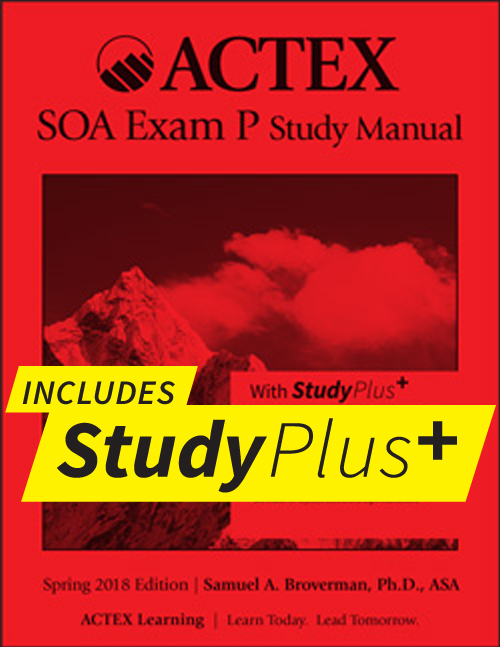Exam P Study Manual 2012
Actuarial exam info Within the actuarial field, there is a certification process that consists of a number of professional exams that must be passed. Go for more general information about these exams. Are some tips for preparing for an actuarial exam, assembled by Matt Imoehl who passed Exams P, FM, and MFE on the first try. The first two exams listed below can be taken in any order, because they do not have overlapping material. (Probability) covers calculus-based probability.
Read and Download Actex Study Manual Exam P 2012 Free Ebooks in PDF format - COMMON CORE GRADE 4 MATH MODULE 4 ESSENTIALS ECONOMICS PAUL KRUGMAN OCE 7050. You should check the exam P syllabus to make sure the manual covers all the material, but I'm pretty sure you'll be fine with a 2012 edition. Is the Actex FM manual a terrible main resource to use when studying for Exam FM?
The application of probabilistic tools to problems encountered in insurance-related situations is emphasized. A thorough command of calculus and probability topics is assumed. Additionally, a very basic knowledge of insurance and risk management is assumed. It is best not to attempt this exam until after taking MATH 341. This exam is offered by the SOA during every odd-numbered month (e.g., January, March, May, etc.). You need to read the document that helps you better understand how to use probability within an insurance or risk management context.
Exam P Study Manual
You can find at the. Be sure to read the syllabus for this exam, because it details what will be covered. Here is a link to a from the SOA (and a ). Here is a (including an answer key) written by Dr. Finan at Arkansas Tech University.
Here is a that I used when studying for Exam P in Summer 2012. You can take. (Financial Mathematics) covers financial mathematics. In particular, this exam covers interest theory (discrete and continuous) and financial derivatives (e.g., options, futures, etc.) It assumes a basic knowledge of calculus (especially geometric series). This exam can be attempted after a student has completed a year of calculus—potentially even as early as the summer after his/her first year in college. This exam is offered by the SOA during every even-numered month (e.g., February, April, June, etc.).
You can find at the. Be sure to read the syllabus for this exam, because it details what will be covered. Here is a (including answer key) written by Dr. Finan at Arkansas Tech University. You can take.
After completing Exams P/1 and FM/2, the next exams that are typically taken involve modeling. (Models for Life Contingencies) covers the theoretical basis of certain actuarial models, while (Models for Financial Economics) covers the theoretical basis of financial models. A thorough knowledge of calculus, probability, and interest theory is assumed. Knowledge of risk management at the level of Exam P is also assumed. Another exam that can be taken after passing Exams P/1 and FM/2 is (Construction and Evaluation of Actuarial Models). This exam covers important actuarial methods that are useful in modeling, beyond those that are seen in Exams MLC and MFE/3F.
The candidate will be required to understand the steps involved in the modeling process and how to carry out these steps in solving business problems. A thorough knowledge of calculus and probability is assumed. If you want to know when a particular exam is scheduled to be given, and.
Exam Study Materials There are numerous places to find study materials for the exams. Here are a few where current students are finding their materials. Free study guides written by Marcel B. Finan at Arkansas Tech University for (including answer key) and (including answer key).
A large set of SOA-sponsored and for Exam P/1. for Exam P/1. has an excellent on-line system for taking (progressively harder) practice exams called Adapt. has some free and very inexpensive study materials for the first few exams. (Search for materials by exam menu on left.).
Validation by Educational Experience (VEE) In addition to taking exams, students seeking certification by the SOA or CAS must also meet three Validation by Educational Experience (VEE) requirements: VEE Economics, VEE Corporate Finance, and VEE Applied Statistical Methods. Each requirement is meant to be satisfied by taking one or two VEE-certified college courses. Currently, students at Central can satisfy all three VEE requirements. VEE Economics: ECON 112 and ECON 113. VEE Corporate Finance: BMGT 361 and BMGT 362.
VEE Applied Statistical Methods (Regression): ECON 281. VEE Applied Statistical Methods (Time Series): ECON 485 (NOTE: This course has the prequisite of ECON 313 and the pre-/co-requisite of ECON 312.) If the prerequisites for ECON 485 make this course difficult to take, then another option for completing the VEE Applied Statistical Methods (Time Series) requirement is to take a correspondence course through.
The Actuarial Science guide provides links to materials relating to becoming an actuary. Study Materials links to key resource to prepare for required actuarial exams focusing on the exams and VEE that may be pursued in St. Mary's actuarial program.
Actex Exam P Study Manual

Databases and Journals lists source for articles on actuarial, insurance, and finance topics. Career as an Actuary lists sources for information about jobs, career prep, and professional associations.
News offers RSS feeds to the latest news about actuarial topics.